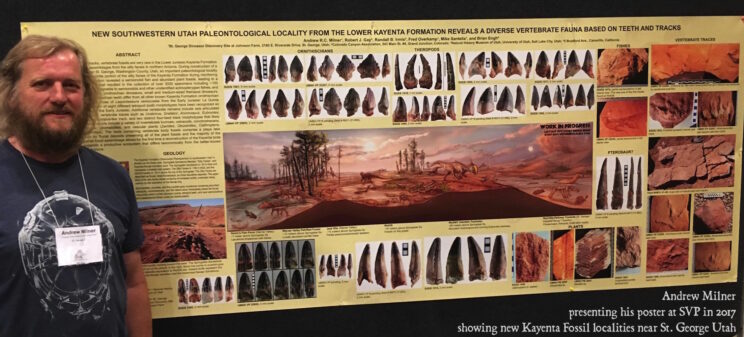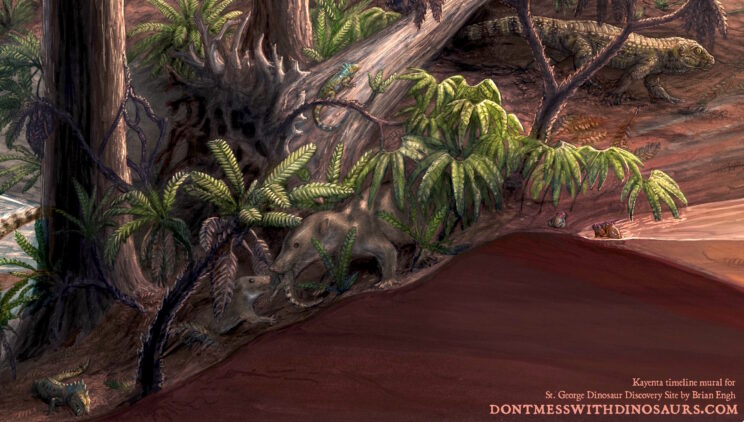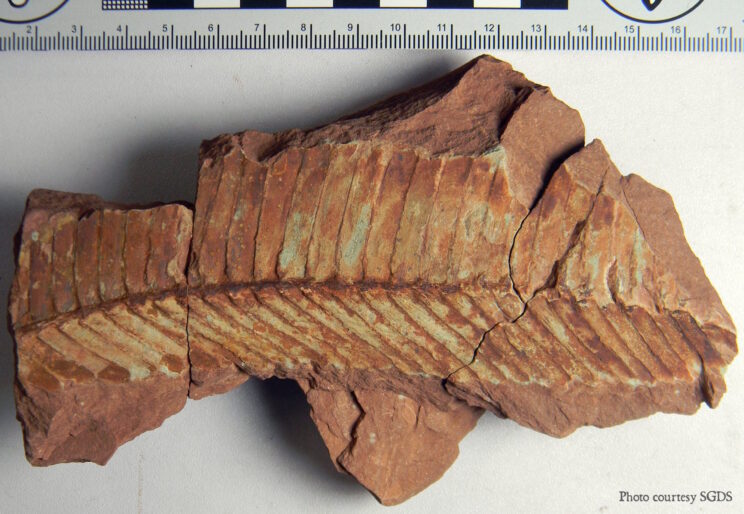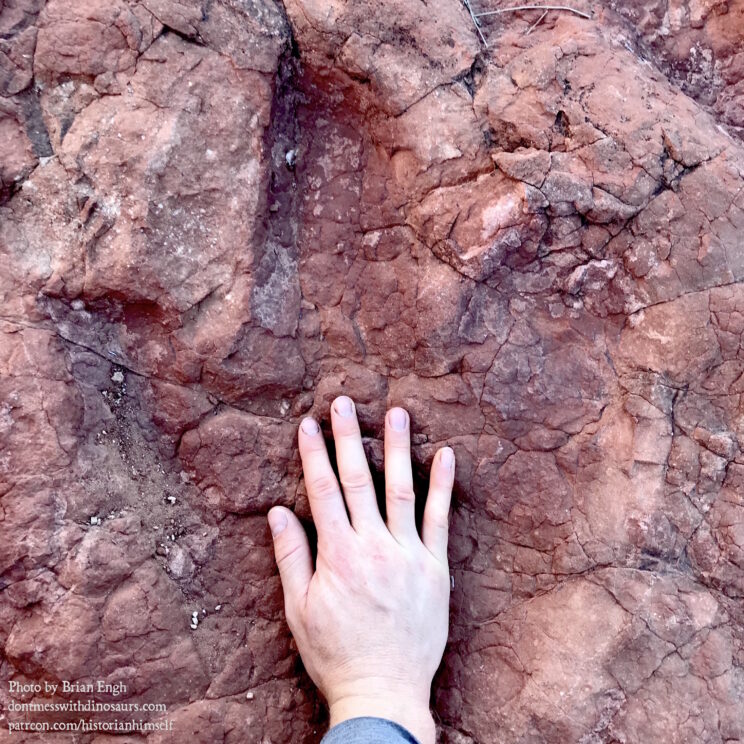I’ve (finally) finished painting The Kayenta Timeline Mural
After 4.5 years of research, drawing and digitally painting I am finally finished with illustrating this massively complex paleoenvironmental reconstruction and the digital mural will soon be printed and installed by the museum as part of their Dawn of the Dinosaurs exhibit. This mural represents a changing early Jurassic landscape at the beginning of the age of dinosaurs, and it is based on a number of new fossil sites discovered in and around St. George Utah, as well as fossils from nearby Northern Arizona.
The above pictures are (relatively) tiny, low res version of this mural which is detailed enough to be printed 5m long. It’ll have to do for now because the larger versions take forever to load and crash browsers.
I don’t want to give TOO much away before it’s all printed up and installed at the museum (which you all should visit, even if you have to migrate on foot across thousands of miles like Jurassic dinosaurs did), so I held a top secret HD live stream for the people who helped fund the completion of this project through my patreon and the gofundme campaign held by the St. George Dinosaur Discovery Site.
If you want to see the full livestream you’ll need to support my art on patreon, or make a donation to the museum.
In this clip, a supporter of the project asks if we can know for certain if any of these environments actually existed at the same time as one another. The short answer is basically yes, some fossil sites and stratigraphic interbedding strongly suggest that some of these environments transitioned into each other in time and space. The long answer is a 6 minute rant with a bunch of specific details about the Kayenta formation and the challenges and uncertainties of interpreting paleoecologies, which you can see here:
I’m sure I could have been more concise, but I often have a hard time expressing my love for the infinite detail of reality in just a few words.
If you’ve been following along, this project has been in the works for a LONG TIME, in part because it is the single most detailed illustration I have ever done by several orders of magnitude, and in part because budgetary challenges, global pandemics, and other projects have interrupted the illustration process on multiple occasions through the 4.5 years this mural was in the works.
The seeds of this project were sewn way back when I was working on the Mastodon mural for Western Science Center. I made a super quick trip out to St. George Utah to meet with SGDS paleontologist Andrew Milner to see the fossil sites he wanted to incorporate into the mural. We found bone and footprints and I was shown one of the most gorgeous stratigraphic sections I have ever seen. The landscape around St. George is absolutely stunning. I (shoddily) recorded Andrew’s field interp in this video:
It became clear from that field visit that what we were embarking on was far more ambitious than I realized. MULTIPLE site-specific paleoenvironmental reconstructions transitioning into one another as the landscape and climate shifted through time. I had seen this time-composite image of all the animals that visit a waterhole in the Serengeti by Stephen Wilkes and it set my mind on fire with the possibility of creating paleoart that attempts to show something similar but over far vaster time scales.
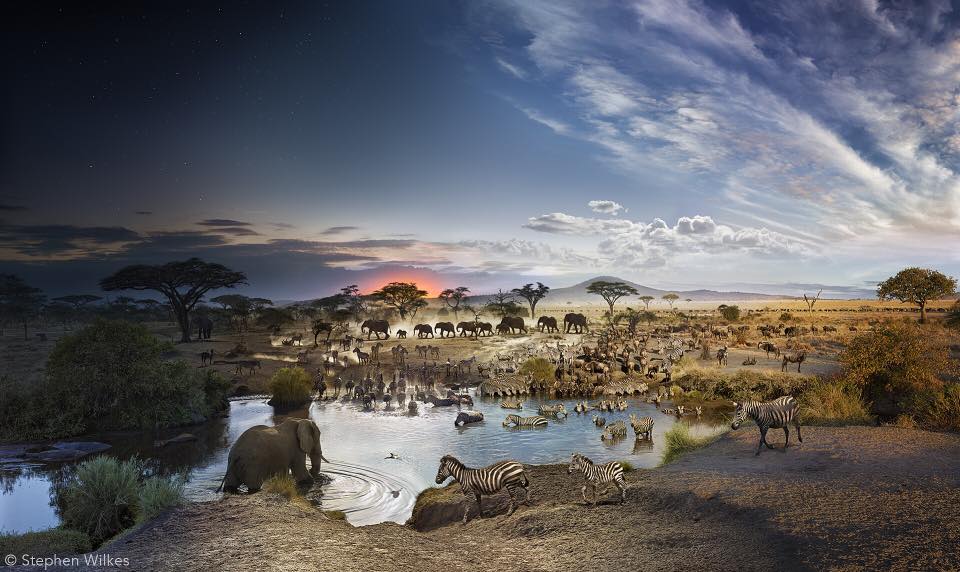
I was SO TURNST UP about this idea. Unfortunately the SGDS museum only had the budget for one small paleoecological scene. So, I did something that artists shouldn’t do, I took the project on anyway.
From gathering fossil reference & insights to learning and figuring out how to display the stratigraphy, the learning curve was grueling on several levels. While the early Jurassic is known for having a sparse fossil record, the actual diversity of animals suggested by even the fragmentary record is pretty astonishing. Considering the abundance of tracks and skeletal fragments my finished mural is honestly way too sparsely populated.
It should probably look more like the above Serengetti scenes, but these kinds of layouts are complicated, and even just rendering a single animal represents many hours of work…and this mural has over a hundred animals… and then there’s the plants – some of which are gorgeously preserved.
At some point along the way the museum’s short-term priorities shifted, so we did a hard pivot and focused on the museum intro video, which was another ambitious multi-year project that involved the creation of several creature puppets to help bring the early Jurassic to life in a live-action location. That project, and all of the important early theropod research that informed the Kayenta timeline ended up all feeding into this video:
It was not easy, but with hard work, perseverance, and the help of some great artist collaborators as well as the support of patrons and gofundme supporters we got it all done.
My huge thanks go out to St. George Dinosaur Discovery site paleontologist Andrew Milner for everything he did to make this project happen and to show me the amazing sites he and his volunteers have found. I also owe a huge debt to gratitude to SGDS Director Diana Call, paleontologist Jerry Harris, and the whole staff at SGDS. It should also not be understated how crucial the suppor of my patreon supporters and all of the people who supported the completion of this mural on gofundme were to getting this done. Yall saved my life on so many occasions. Much love, respect, and gratitude.


